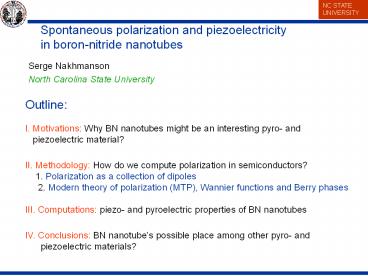Outline: - PowerPoint PPT Presentation
1 / 29
Title:
Outline:
Description:
Spontaneous polarization and piezoelectricity in boron-nitride nanotubes Serge Nakhmanson North Carolina State University Outline: I. Motivations: Why BN nanotubes ... – PowerPoint PPT presentation
Number of Views:117
Avg rating:3.0/5.0
Title: Outline:
1
Spontaneous polarization and piezoelectricityin
boron-nitride nanotubes
Serge Nakhmanson North Carolina State University
Outline I. Motivations Why BN nanotubes might
be an interesting pyro- and piezoelectric
material? II. Methodology How do we compute
polarization in semiconductors? 1.
Polarization as a collection of dipoles 2.
Modern theory of polarization (MTP), Wannier
functions and Berry phases III. Computations
piezo- and pyroelectric properties of BN
nanotubes IV. Conclusions BN nanotubes
possible place among other pyro- and
piezoelectric materials?
2
I. Two main classes of industrial
pyro/piezoelectrics
3
I. Properties of BN nanotubes
BN nanotubes as possible pyro- and piezoelectric
materials excellent mechanical properties
light and flexible, almost as strong as carbon
nanotubes (Zhang and Crespi, PRB
2000) chemically inert proposed to be used as
coatings all insulators with no regard to
chirality and constant band-gap of around 5
eV intrinsically polar due to the polar nature
of B-N bond most of the BN nanotubes are
non-centrosymmetric (i.e. do not have center of
inversion), which is required for the existence
of non-zero spontaneous polarization
4
I. Applications
- Neat nanodevices that can be made out of pyro-
- and piezoelectric nanotubes
- actuators
- transducers
- strain and temperature sensors
Images from B. G. Demczyk et. al. APL 2001
5
II. Polarization as a collection of dipoles
How was polarization computed before MTP?
Information about the charge transfer through the
surface of the cell is required to compute
polarization. Such cell dipole moment is not a
bulk property (cell shape dependent).
6
II. Modern Theory of Polarization
References R. D. King-Smith D. Vanderbilt,
PRB 1993 R. Resta, RMP 1994
1) Polarization is a multivalued quantity (taking
on a lattice of values) and its absolute
value can not be computed.
2) Polarization derivatives are well defined and
can be computed
At zero external field
7
II. Computing polarization Wannier function
connection
8
II. Berry phases
9
III. Software for polarization computations
Berry phases Massively parallel ab initio
real space LDA-DFT method with multigrid
acceleration (E.L. Briggs, D.J. Sullivan and J.
Bernholc, PRB 1996). Available at
http//nemo.physics.ncsu.edu/software/MGDFT-QMD/
Wannier functions Post-processing routine
for generation maximally localized Wannier
functions for entangled energy bands (Marzari and
Vanderbilt, PRB 1997 Souza, Marzari and
Vanderbilt, PRB 2001).
10
III. Nanotube primer
Armchair
Zigzag
11
III. Folding hexagonal BN into a nanotube
sheet of hexagonal BN
12
III. What should we expect from BNNTs
polarization-wise?
Polarization as a collection of dipoles
13
III. Piezoelectric properties of zigzag BN
nanotubes
Born effective charges
Piezoelectric constants
(w-GaN and w-ZnO data from F. Bernardini, V.
Fiorentini, D. Vanderbilt, PRB 1997)
14
III. Piezoelectric properties of zigzag BN
nanotubes
Born effective charges
Piezoelectric constants
(w-GaN and w-ZnO data from F. Bernardini, V.
Fiorentini, D. Vanderbilt, PRB 1997)
15
III. Piezoelectric properties of zigzag BN
nanotubes
Born effective charges
Piezoelectric constants
(w-GaN and w-ZnO data from F. Bernardini, V.
Fiorentini, D. Vanderbilt, PRB 1997)
16
III. Ionic phase in zigzag BN nanotubes
17
III. Ionic phase in zigzag BN nanotubes
18
III. Electronic phase in zigzag BN nanotubes
Berry-phase calculations provide no recipe for
unfolding the electronic phase!
19
III. Problems with electronic Berry phase
20
III. Wannier functions in flat C and BN sheets
Carbon
Boron-Nitride
?
?
No spontaneous polarization in BN sheet due to
the presence of the three-fold symmetry axis
21
III. Wannier functions in C and BN nanotubes
Carbon
Boron-Nitride
22
III. Unfolding the electronic phase
(5,0) -5/3? 2? ?/3
(6,0) -6/3? 1? -?
(7,0) -7/3? 2? -?/3
(8,0) -8/3? 3? ?/3
23
Total phase in zigzag nanotubes
Zigzag nanotubes are not pyroelectric! What
about a more general case of chiral nanotubes?
24
III. Extending to (n,m) nanotubes example with
ionic phase
25
III. General formula for polarization in BN
nanotubes
Chiral nanotubes
(n,m) R (bohr)
3,1 2.67 -1/3 0.113 -0.222
3,2 3.22 1/3 -1/3 0 mod(p)
4,1 3.39 1 1 0 mod(p)
4,2 3.91 -1/3 1/3 0 mod(p)
5,2 4.62 1 -1 0 mod(p)
8,2 6.78 0 1 0 mod(p)
All wide BN nanotubes are not pyroelectric! Is
the screw symmetry in BNNTs too strong to support
polarization? What happens when symmetry is
reduced? Or may the pseudo 1D character of BNNTs
be responsible for the absence of polarization?
26
IV. BN nanotubes place among other polar
materials
27
IV. Conclusions
- Materials Science
- Compared to wurtzite compounds and
piezoelectric polymers, BN nanotubes are good
piezoelectric materials that could be used for a
variety of novel nanodevice applications - Piezoelectric sensors
- Field effect devices and emitters
- Nano-Electro-Mechanical Systems (NEMS)
- Physics
- Quantum mechanical theory of polarization
in BN nanotubes in terms of Berry phases and
Wannier function centers BN nanotubes have no
spontaneous polarization! - Is it because the screw symmetry is too strong?
- What happens when the screw symmetry is broken
bundles, multiwall - nanotubes?
- Does the reduced dimensionality of BN nanotubes
have anything to do with vanishing spontaneous
polarization?
28
Acknowledgments
NC State University group Jerry Bernholc
Marco Buongiorno Nardelli (also at ORNL)
Vincent Meunier (now at ORNL)
Wannier function code collaboration Arrigo
Calzolari (Universita di Modena, Italy) Nicola
Marzari (MIT) Ivo Souza (Rutgers)
Computational facilities DoD Supercomputing
Center NC Supercomputing Center
Funding NASA ONR
29
II. Computing the electronic phase











![[PDF] DOWNLOAD FREE Clinical Outline of Oral Pathology: Diagnosis and PowerPoint PPT Presentation](https://s3.amazonaws.com/images.powershow.com/10076578.th0.jpg?_=20240711025)




![[READ]⚡PDF✔ Black Letter Outline on Contracts (Black Letter Outlines) 5th Edition PowerPoint PPT Presentation](https://s3.amazonaws.com/images.powershow.com/10044064.th0.jpg?_=20240531080)














